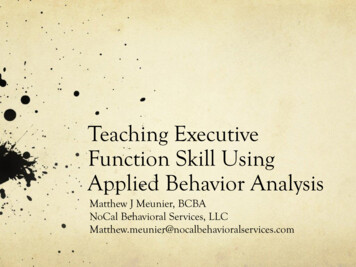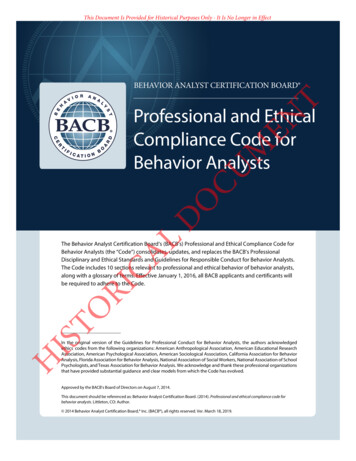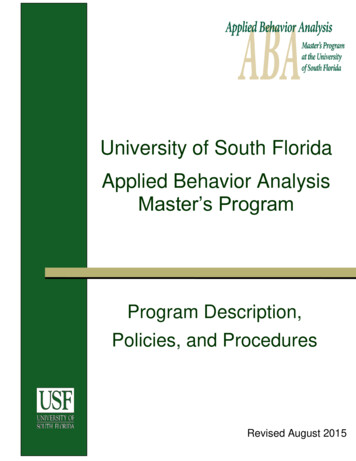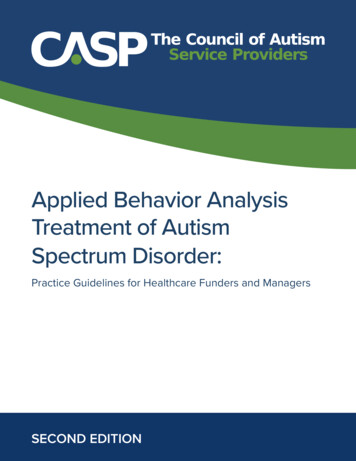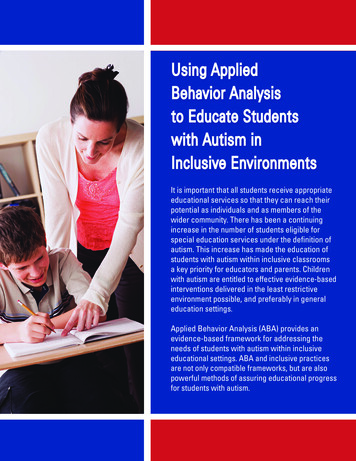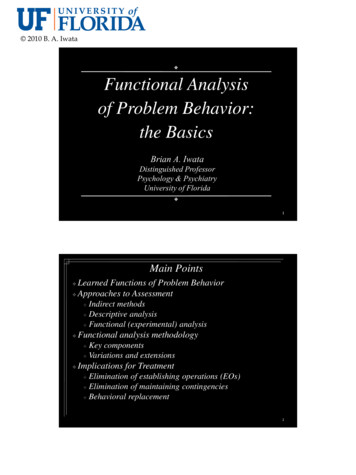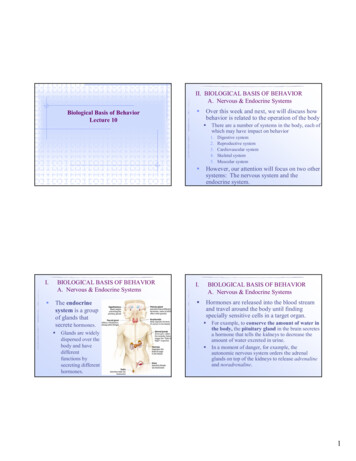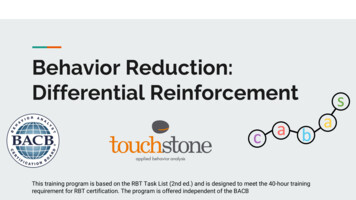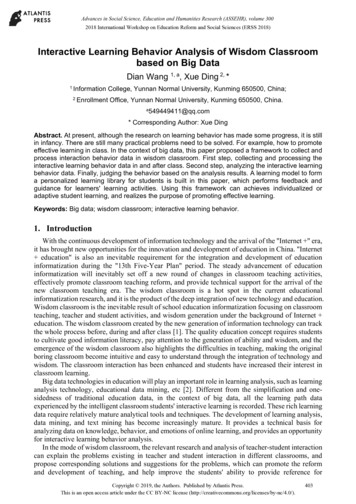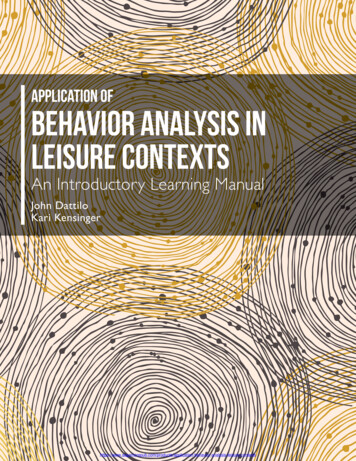
Transcription
Application ofBEHAVIOR ANALYSIS INLEISURE CONTEXTSAn Introductory Learning ManualJohn DattiloKari ication-behavior-analysis-leisure-contexts
Application ofBEHAVIOR ANALYSIS INLEISURE CONTEXTSAn Introductory Learning ManualJohn DattiloKari ication-behavior-analysis-leisure-contexts
2016 Sagamore Publishing, LLCAll rights reserved.Publishers: Joseph J. Bannon and Peter L. Bannon6DOHV DQG 0DUNHWLQJ 0DQDJHUV (PLO\ :DNH¿HOG DQG 0LVWL *LOOHVDirector of Development and Production: Susan M. DavisProduction Coordinator: Amy S. Dagit*UDSKLF 'HVLJQHU 0DULVVD :LOOLVRQLibrary of Congress Control Number: 2015948483ISBN print edition: 978-1-57167-781-5ISBN ebook: 978-1-57167-782-2Printed in the United States.1807 N. Federal Dr.Urbana, IL isure-contexts
We dedicate this book to the many wonderful peoplewhose lives we have humbly attempted to enhance;they have taught us much and touched our lication-behavior-analysis-leisure-contexts
ehavior-analysis-leisure-contexts
ContentsPreface .viiSection A: Examine and Assess Behaviors1 Introduction to Behavior Analysis . 12 Describe Behaviors . 73 Observe Behaviors .134 Measure Behaviors . 235 Assess Preferences . 356 Sequence Analysis . 43Section B: Accelerate and Decelerate Behaviors7 Accelerate Behaviors: Positive Reinforcement . 498 Accelerate Behaviors: Token Economies . 599 Decelerate Behaviors: Negative Reinforcement. 6710 Decelerate Behaviors: Extinction . 7511 Decelerate Behaviors: Punishment. 8312 Decelerate Behaviors: Withdrawal of Reinforcement . 93Section C: Teach Behaviors13 Implement Schedules of Reinforcement .10514 Shape Behaviors . 11515 Chain Behaviors Together .12316 Provide Discrete Trials . 13117 Develop Functional Communication .139Section D: Discriminate Between and Maintain Behaviors18 Promote Discrimination . 14719 Generalize Behaviors .155Section E: Be Consistent and Informed20 Support Positive Behaviors .16321 Use Evidence-Based Practice . 171Conclusion . 181Glossary .186References and Resources .190Index . on-behavior-analysis-leisure-contexts
ehavior-analysis-leisure-contexts
PrefaceThis self-study learning manual is designed to introduce leisure service providers and students to behavior analysis and to assist them in developing and strengthening their skills in the application of associated techniques. The manual may be of value to other human service providers who are interested inapplying behavior analysis techniques in situations designed to promote leisure engagement. It is our hopethat this manual will assist those individuals who are dedicated to helping others engage in leisure. Leisureengagement leads to people experiencing meaning and enjoyment in their lives and, ultimately, increasestheir happiness and their ability to flourish.This manual assumes that the reader has no previous knowledge of behavior analysis. The text containsfive major sections with 21 associated chapters. The first section is devoted to examining and assessing behaviors that includes details on ways to describe, observe, and measure behaviors. This section also focuseson preference assessment and understanding behaviors through sequence analysis. The second sectiondescribes ways to influence behaviors by accelerating or decelerating behaviors. Procedures identified toaccelerate behaviors conducive for leisure participation include positive reinforcement, token economies,and negative reinforcement. Extinction, punishment, and withdrawal of reinforcement are strategies designed to decelerate behaviors that are incompatible with leisure engagement. The third section identifiesstrategies to help teach behaviors facilitating leisure involvement that include schedules of reinforcement,shaping behaviors, chaining behaviors together, providing discrete trials, and developing functional communication. The fourth section of the manual provides details on promoting discrimination and generalization of behaviors with the purpose of encouraging maintenance and generalization of behaviors thatfacilitate leisure participation. The final section encourages readers to be consistent and informed in theirapplication of behavior analysis procedures. As a result, this section contains information on supportingpositive behaviors and using evidence-based practices.Each chapter contains descriptions of procedures and associated exercises. A series of questions isprovided at the end of each chapter to allow readers to test their acquisition and retention of the materialaddressed in the chapter. An answer key is included at the end of the manual to assist readers in evaluatingtheir answers. We hope that readers find the manual to be helpful in improving their ability to interactwith people in a helpful and respectful manner and create contexts that encourage leisure /application-behavior-analysis-leisure-contexts
ehavior-analysis-leisure-contexts
Section A: Examine and Assess Behaviors1 INTRODUCTION TO BEHAVIOR ANALYSISBehavior analysis includes a systematic approach to understand behavior used by many professionalsincluding those who provide leisure services. In recent years, the field of behavior analysis has grown inpopularity because there is considerable research documenting the effectiveness of the approach. Althoughthis book is about behavior analysis in leisure contexts, the concepts of leisure and play are embedded intothe practice of behavior analysis.An understanding of introductory techniques of behavior analysis can provide practitioners with helpful techniques to encourage positive behavior and discourage negative behaviors while people are engagedin leisure pursuits. The appropriate application of the procedures described in this book can encourageservice providers to more effectively encourage individuals to engage in enjoyable and meaningful leisureexperiences. An advantage of behavior analysis is that it can be used in any setting or circumstance wherepeople interact with each other or their environment.Behavior analysis is a systematic, performance-based, evaluative method for changing behavior. Behavior is any observable and measureable act, response, or movement by an individual. A behavior that isidentified in need of improvement or change is referred to as a target behavior. Behavior analysis involvesapplication of procedures designed to change behavior in a measurable manner.Behavior analysis originates from the belief that behaviors are learned, rather than inherent, and canthus be changed by additional learning. Behavior analysis seeks to avoid inferences, vague reasoning, orundefined impulses as explanations for behavior. Whatever the behavior and whatever its cause, the behavior is present in an environment and is influenced and shaped by that environment. Behavior analysisfocuses on the following: Observable and measureable behaviorsThe environmentGoals and objectivesPlanning and implementationTeaching techniquesAntecedent, behaviors, and consequencesEvaluation and documentationBehavior is the concern of behavior analysis, and it is behavior that can be changed. Behavior analysisis not a process concerned with attempts to determine the causes of behavior. The procedures used in behavior analysis focus on observable and measurable behaviors rather than presume influential internalagents. This approach does not deny the existence of internal agents, but rather concentrates specificallyon the observable behaviors exhibited by an individual. Regardless of what is causing the behavior, it isbehavior that can be observed and measured. Internal behavioral agents cannot be seen, nor can they bemeasured with any certainty or precision. Behavior is the focus of behavior analysis because it is behaviorthat can be changed by environmental manipulation.Behavior analysis is based on the premise that humans are reactors to their environment. The environment contains all the circumstances, objects, people, behaviors, and conditions that an individual encounters. The emphasis in behavior analysis is placed on the relationship between changes in the environmentand changes in the individual’s behavior. Through environmental manipulation, an individual’s behaviorcan change.The procedures of behavior analysis are very compatible with the programming approach used by leisure service providers and other professionals. Based on the needs of participants, professionals developgoals and objectives designed to promote leisure engagement of program participants. The concentrationon measurable behaviors in behavior analysis facilitates identification of participant needs and subsequentdevelopment of explicit objectives. These goals and objectives provide direction in determining the deliveryof appropriate leisure lication-behavior-analysis-leisure-contexts
Behavior Analysis in Leisure ContextsProcedures used in behavior analysis are considered during the planning phase of developing leisureprograms and applied during the actual implementation phase of the program. Professionals implementing behavior analysis techniques can assist participants in achieving program objectives by facilitating theacceleration of positive behaviors that are beneficial in a specific context, while decreasing behaviors thatare disruptive of problematic for that context.Application of the principles of behavior analysis can facilitate identification of successful teachingtechniques. This identification encourages more frequent and systematic application of effective, precise,and clear learning strategies. As a result, behavior analysis techniques can be easily incorporated into professionals’ existing repertoire of skills dedicated to facilitating the leisure experience and can be appliedacross a variety of settings.Behavior analysis involves careful observation and analysis of individuals’ behaviors by examining therelationship among behavioral antecedents, the behaviors themselves, and the consequences of thesebehaviors occurring in the environment. The emphasis in behavior analysis on the identification of observable and measurable target behaviors as well as on the antecedents and consequences of these behaviorsenhances the ability of service providers to conduct systematic program evaluation.Conducting effective program evaluation allows professionals to clearly document program effectiveness. Documentation of program effectiveness increases the ability of professionals to demonstrate theprovision of quality services and subsequent enhancement of participants’ leisure lifestyles.Try the Following ExerciseIdentify if the following statements are TRUE or FALSE by placing a T or an F in the space immediately to the left of the statement.1. Implementation of principles associated with behavior analysis should be restricted to clinicalsettings.2. A behavior is defined as any observable and measurable act, response, or movement by a person.3. Behavior analysis originates from the belief that many behaviors occur spontaneously, withoutprior learning.4. Behavior analysis focuses on measurable and observable behaviors rather than internal agents.5. Behavior analysis is primarily concerned with the relationship of an individual’s behavior andassociated feelings.6. The environment contains all the circumstances, objects, people, behaviors, and conditions that aperson encounters.7. The professional develops goals and objectives based on the interests and expertise of existingpersonnel.8. Procedures used in behavior analysis should be considered during the planning, implementation,and evaluation phases of a leisure program.9. Behavior analysis focuses on the individuals’ behavior and is not concerned with what occursbefore or after the target behavior.10. Effective program evaluation increases the ability of professionals to document program effectiveness.Please see the next page to determine the accuracy of your plication-behavior-analysis-leisure-contexts
Chapter One: Introduction to Behavior AnalysisAll statements associated with odd numbers are FALSE and all statements corresponding to evennumbers are TRUE.In review, the following are characteristics of behavior analysis: Evaluates methods for changing behaviorsOriginates from the belief the behaviors are learnedFocuses on observable and measurable behaviorsBased on premise that humans are reactors to the environmentIs compatible with recreation programmingShould be considered during program planning and implementationFocuses on antecendents, behaviors, and consequencesFacilitates evaluation of behavior and programsYou have now completed the introductory material on behavior analysis. Next you can evaluate howwell you retained the information on the following ation-behavior-analysis-leisure-contexts
Behavior Analysis in Leisure ContextsTest Your Knowledge of an Introduction to Behavior Analysis1. Behavior may be defined as:a.b.c.d.e.a systematic method for changing the environment.observable and measurable acts, responses, or movements by an individual.the emotional response of individuals to unfamiliar environments.the physical movements or actions of an individual.the presence of internal impulses that cause an individual to act in an inappropriate manner.2. Behavior analysis is a systematic method for:a.b.c.d.altering or changing behavior.determining the causes of behavior.determining the presence of internal agents.estimating the effects of behavior in social environments.3. Behavior analysis procedures may be used:a.b.c.d.e.in any setting where humans interact with each other or their environment.only by certified therapeutic recreation specialists.only in clinical settings.only with individuals who have emotional limitations.only with individuals who have physical disabilities.4. Behavior analysis is based on the premise that:a.b.c.d.e.behaviors are determined by internal agents.behaviors are inherent, rather than learned.behaviors are learned, rather than inherent.internal agents are determined by behaviors.internal agents are determined by environments.5. A target behavior that is:a.b.c.d.e.a model to be adopted by an individual in a behavior analysis program.aimed at modifying the environment.exhibited by the individual who is applying behavior analysis techniques.the focus of systematic efforts aimed at altering it.to remain unchanged by an individual in a behavior analysis program.6. Behavior analysis focuses on:a.b.c.d.e.hypotheses to be tested.individuals with disabilities.inferences.internal agents.observable and measureable plication-behavior-analysis-leisure-contexts
Chapter One: Introduction to Behavior Analysis7. A basis for behavior analysis is the belief that:a.b.c.d.e.change in internal agents can cause change in the environment.changes in the environment can effect a change in behavior.internal agents can be measured with the same precision as external agents.the cause of a behavior must be identified before the behavior can be modified.it is easier to identify internal agents than it is external agents.8. Behavior analysis emphasized the concept that:a.b.c.d.e.behavior cannot be influenced by environmental manipulation.humans are not influenced by their environments.humans react only to internal agents.humans react to their environment.target behaviors must remain unchanged.9. Behavior analysis is based on:a.b.c.d.environmental manipulation.manipulation of internal agents.the belief that behavior is an inherent trait.the belief that clinical settings are the best environments for behavior analysis procedures to beapplied.e. the belief that target behaviors must not be changed.10. Environmental manipulation can facilitate:a.b.c.d.e.change in an individual’s behavior.the determination of causes of behavior.the measurement of internal agents.the reduction of the influence of leisure as a determinant of lifestyle.the reduction of the strength of internal agents.11. Behavior analysis procedures are:a.b.c.d.e.compatible with the concept that behavior is inherent.compatible with programming approaches used by leisure service providers.incompatible with programming approaches used by leisure service providers.most useful when applied in clinical settings.most useful when focused on internal agents.12. Behavior analysis procedures should first be considered during the:a.b.c.d.e.acceleration phase of leisure programs.delivery phase of leisure programs.evaluation phase of leisure programs.implementation phase of leisure programs.planning phase of leisure lication-behavior-analysis-leisure-contexts
Behavior Analysis in Leisure Contexts13. Behavior analysis procedures should:a.b.c.d.e.decrease the strength of behaviors that are appropriate in a specific context.increase the strength of behaviors that are appropriate in a specific context.increase the strength of behaviors that are inappropriate in a specific context.increase the strength of internal agents.neutralize the effects of environmental manipulation.14. Behavior analysis techniques are:a.b.c.d.e.easily incorporated into the repertoire of skills possessed by recreation professionals.too sophisticated to be applied by recreation professionals.useful only in clinical settings.useful only in natural environments.useful only when applied to individuals with disabilities.15. Behavior analysis involves the analysis of behavior and their:a.b.c.d.e.antecedents and consequences.effect on the environment.effect on recreation professionals.expression during leisureinternal causes.Now that you have completed the evaluation, please check your answers with the ones in the back ofthe book. If needed, review the introductory material on behavior analysis and try the evaluation again.When you are satisfied with your acquisition of the information and understand the concepts, begin workon the next ication-behavior-analysis-leisure-contexts
Behavior analysis originates from the belief that behaviors are learned, rather than inherent, and can thus be changed by additional learning. Behavior analysis seeks to avoid inferences, vague reasoning, or undefined impulses as explanations for behavi
